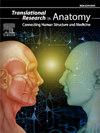Aberrant origin of left vertebral artery: A molecular embryological perspective
Q3 Medicine
引用次数: 0
Abstract
Background
Variation in the origin and course of the left vertebral artery have surgical and clinical implications in the management of medical conditions. Here, we show variant origin of the left vertebral artery in cadavers and propose potential causes for future molecular investigations.
Method
The aortic arches of 32 donors were dissected and observed for anomalous origin of the left vertebral artery in the cadaver laboratory at the University of Toledo, Ohio, USA.
Results
Out of 32 donors dissected during laboratory sessions, we observed two cases of the left vertebral artery originating directly from the aortic arch, medial to the left subclavian artery.
Conclusion
The study aims to stimulate discussions and future investigations into the molecular embryology of vasculogenesis concomitant with preconceptional and in utero exposures to understand the underlying causes of aberrant origin of the left vertebral artery. Additionally, we speculate that parental and embryonic environmental exposures influence the epigenetic landscape in germ cells and early embryos, thereby contributing to the programming of variant origin of blood vessels.
左椎动脉异常起源:分子胚胎学观点
背景:左椎动脉起源和路径的变异在医疗条件的处理中具有外科和临床意义。在这里,我们展示了尸体左椎动脉的不同起源,并提出了未来分子研究的潜在原因。方法在美国俄亥俄州托莱多大学尸体实验室解剖32例供体主动脉弓,观察左椎动脉异常起源。结果在实验室解剖的32例供体中,我们观察到2例左椎动脉直接起源于主动脉弓,位于左锁骨下动脉内侧。结论本研究旨在促进对血管发生的分子胚胎学的讨论和未来的研究,以了解左椎动脉异常起源的潜在原因。此外,我们推测亲代和胚胎的环境暴露会影响生殖细胞和早期胚胎的表观遗传景观,从而促进血管变异起源的编程。
本文章由计算机程序翻译,如有差异,请以英文原文为准。
求助全文
约1分钟内获得全文
求助全文
来源期刊

Translational Research in Anatomy
Medicine-Anatomy
CiteScore
2.90
自引率
0.00%
发文量
71
审稿时长
25 days
期刊介绍:
Translational Research in Anatomy is an international peer-reviewed and open access journal that publishes high-quality original papers. Focusing on translational research, the journal aims to disseminate the knowledge that is gained in the basic science of anatomy and to apply it to the diagnosis and treatment of human pathology in order to improve individual patient well-being. Topics published in Translational Research in Anatomy include anatomy in all of its aspects, especially those that have application to other scientific disciplines including the health sciences: • gross anatomy • neuroanatomy • histology • immunohistochemistry • comparative anatomy • embryology • molecular biology • microscopic anatomy • forensics • imaging/radiology • medical education Priority will be given to studies that clearly articulate their relevance to the broader aspects of anatomy and how they can impact patient care.Strengthening the ties between morphological research and medicine will foster collaboration between anatomists and physicians. Therefore, Translational Research in Anatomy will serve as a platform for communication and understanding between the disciplines of anatomy and medicine and will aid in the dissemination of anatomical research. The journal accepts the following article types: 1. Review articles 2. Original research papers 3. New state-of-the-art methods of research in the field of anatomy including imaging, dissection methods, medical devices and quantitation 4. Education papers (teaching technologies/methods in medical education in anatomy) 5. Commentaries 6. Letters to the Editor 7. Selected conference papers 8. Case Reports
 求助内容:
求助内容: 应助结果提醒方式:
应助结果提醒方式:


